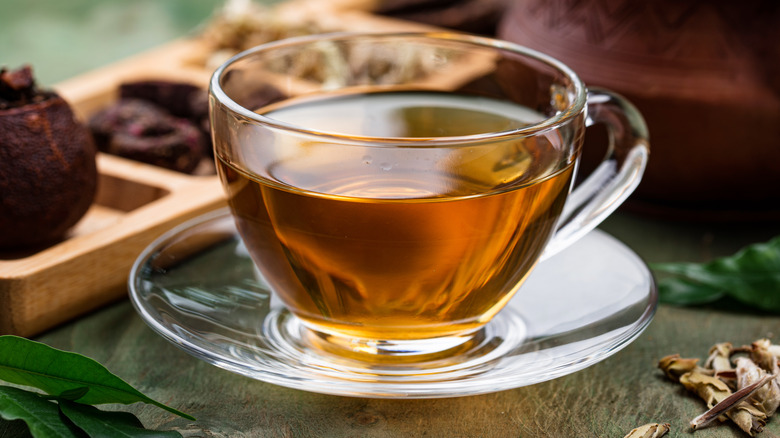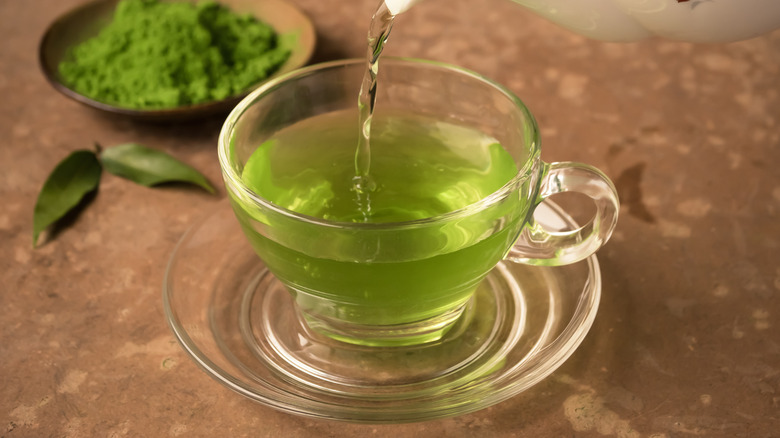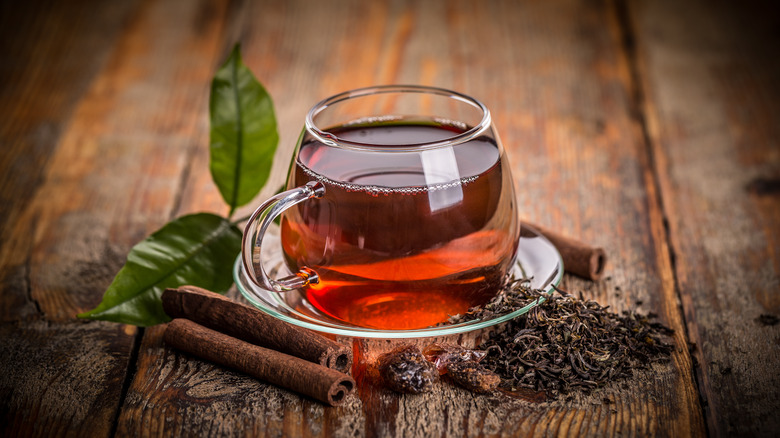You Can't Have A Perfect Cup Of Decaf Tea Without Dumping It Out First
We may receive a commission on purchases made from links.
Even though tea has been around for centuries, people still can't agree on what's the best way to make a cup today. If you ask 10 different tea drinkers what the best way to make a cup of tea is, you'll get 10 different answers, plus a massive argument. Fortunately, science has put its foot down where decaf tea is concerned. For the best drink that won't keep you awake until 5 a.m. on a workday, according to Michelle Francl, Ph.D., in her book "Steeped: The Chemistry of Tea," you need to brew it twice. This is because tea releases caffeine quickly, though the amount of caffeine can vary based on the heat of the water, your brewing time and technique, and the leaves' oxidation level. (In general, the hotter the water and the longer the steep, the higher the concentration of caffeine.)
Start by steeping a teaspoon of loose green tea leaves in ¼ cup (1½ ounces) of sufficiently hot water for three minutes. For tea bags (which can even be fashioned from coffee filters), Francl advises that a 30-second initial steep will suffice. Discard this caffeine-rich liquid, but don't toss out the leaves or tea bags just yet. Now, you can pour fresh hot water over them and brew as you normally would, and voilà, an 80%-caffeine-reduced cup of green tea!
The science of decaffeination
Decaf tends to get a bad rap compared to the normal, caffeinated stuff. But if you really like the scent or the flavor of your prized tin of Japanese Hojicha green tea, but still have to get up bright and early tomorrow, the good news is that by understanding the science behind caffeination, you can do it at home with almost any tea blend you have.
As Michelle Francl wrote in her book, caffeine is highly soluble in water (hydrophilic). In contrast, the compounds responsible for tea's flavor and scent, such as tannins, are less water-soluble (hydrophobic). By brewing the tea for a very short period initially, you can extract much of the caffeine into the water while leaving behind many of the flavorful components. When you brew for the second time, the remaining flavors and aromas in the leaves are released. So, you'll get a pretty good cup with less than ¼ of the caffeine content.
It's worth noting, however, that homemade decaf tea will still have a similarly watered-down taste as commercially produced decafs. After all, caffeine itself plays a key role in the flavor profile of tea with its bitterness. Without it, regrettably, the drink just doesn't taste the same. But for some, turning green tea from one of the worst drinks to sip before bed into a sleep-friendlier version is worth it.
What about black tea?
Michelle Francl noted that the trick above will work best for green tea. As for black tea, because it has a distinct chemical makeup, the double-brewed decaf version just doesn't taste very good. You can certainly try if you're short on options, but it'll be better to turn to commercially-made decaf black tea if you're after a good sleep. They use special solvents and decaffeination techniques to "juice out" the caffeine. Some of the flavors and scent will still be lost as usual, but it'll taste better than the double-steeped, homemade black decaf tea.
If all these flavor losses sound horrible to you, then you'll find tisane (herbal teas) more agreeable. Not only are they entirely caffeine-free (even teas that are supposedly fully decaf contain trace amounts), but the list of herbal blends is long and varied enough that you won't have much problem finding something that suits your taste. Sure, you may not get the warm, vegetal notes of your favorite tea blend, but tisanes can still do a crack job at being a warm, comforting drink that sends you on your way to a good night's sleep.


